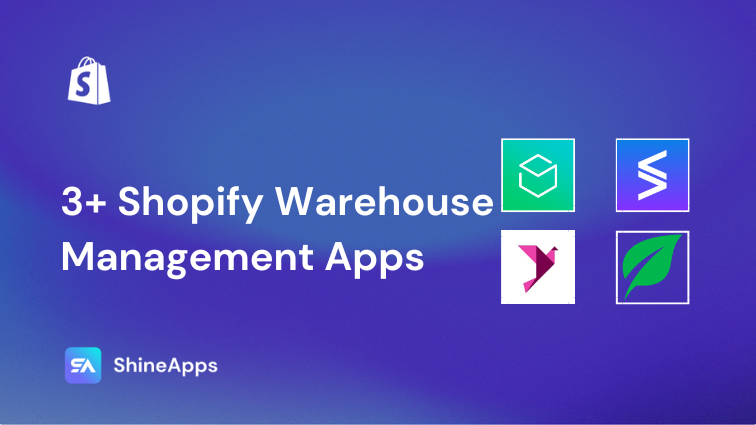3+ Shopify Warehouse Management Apps
- By Lan Anh

Are you tired of spending countless hours managing your Shopify warehouse manually? Fear no more! In this article, we will introduce you to 3+ game-changing Shopify warehouse management apps that will revolutionize how you handle inventory.
A Quick Comparison of The 3+ Shopify Warehouse Management Apps
| Logo | App Name | Pricing | Free Trial | Rating |
|---|---|---|---|---|
| Stocky | Free to install | ❌No | 3.7/5⭐ | |
| Stock Sync: Inventory Sync | Free plan available. From $5/month | ✔️Yes (14 days) | 4.7/5⭐ | |
| Extensiv Order Manager | $1,000/month | ❌No | 4/5⭐ | |
| Thrive by Shopventory | From $99/month | ✔️Yes (30 days) | 4.9/5⭐ |
The In-depth Reviews
#1. Stocky
Stocky is an app that integrates with Shopify POS Pro and allows you to create and manage purchase orders, receive product recommendations, replenish stock, conduct stocktakes, and use in-depth reporting. The app is designed to help you optimize your inventory decisions and maximize your profits with the best product mix for your business.
Key features:
- Create and manage purchase orders and communicate with suppliers
- Receive product recommendations based on which are the most profitable
- Replenish stock quickly to meet demand and transfer products between locations
- Conduct stocktakes by counting or scanning stock on hand and make adjustments
- Use in-depth reporting to make good inventory decisions through stock analytics
Pricing:
- Free to install (Included with Shopify POS Pro subscription)
#2. Stock Sync: Inventory Sync
The second app on our list is Stock Sync. It connects with various sources and formats like CSV, XLS, and Google Sheets. With Stock Sync, you can import and export inventory data from multiple suppliers, saving time and improving accuracy. This app is designed to increase customer satisfaction and boost sales.
Key features:
- Import new products and update inventory levels by automating the process from multiple suppliers
- Avoid overselling by using quantity rules to adjust stock levels accordingly
- Remove any unwanted or discontinued products from the store
- Export inventory to supplier or vendor to track stock held in store
- Be a dropshipper with Stock Sync and share your feed with other merchants
Pricing:
- Free
- Basic: $5/month
- Pro: $15/month
- Business: $25/month
#3. Extensiv Order Manager
Extensiv Order Manager, previously called Skubana, is a powerful app that seamlessly connects with your various sales channels and shipping carriers. With this tool, you can automate repetitive tasks, create order manipulation rules, manage inventory efficiently, predict future demand, and gain centralized insights and visibility. Ultimately, Extensiv Order Manager aims to enhance your profitability, streamline operations, and improve overall efficiency.
Key features:
- Automate routine tasks and build order manipulation rules
- Control and replenish inventory with warehouses and 3PL partner integration
- Forecast future demand with integrated inventory automation tools
- Centralize insights and visibility with real-time dashboards and aggregated data
Pricing:
- $1,000/month
#4. Thrive by Shopventory
Thrive, the final app on our list, is a comprehensive tool for managing inventory, sales, and reporting across various channels and platforms. It seamlessly syncs data in real time from Shopify, Shopify POS, Square, Clover, and Google Shopping to provide a holistic view of your business performance.
Key features:
- Real-time stock and catalog syncing with multi-location and point-of-sale integrations
- Data-rich reporting by location and sales channel
- Automate purchase orders to restock product
- Use a scanner to count, transfer and reorder product
- Connect multiple Shopify accounts for an all-in-one experience
- Assemblies and manufacturing workflows to take your business to the next level
Pricing:
- Standard: $99/month
- Professional: $249/month
- Elite: $499/month
- Enterprise: $999/month
The In-depth Reviews
In this article, we have reviewed some of the best Shopify warehouse management apps available. We hope this article has helped you narrow your choices and make an informed decision. Some offer free trials or demos, so you can test them before committing. Remember, the best Shopify warehouse management app for you is the one that meets your specific goals and challenges!
Related Best Shopify
App Collections
FAQs
Warehouse management is the operational processes that help a warehouse run efficiently. These processes include tracking inventory levels, locating goods, managing staff schedules, fulfilling orders, and optimizing warehouse space.
A WMS is a software that supports and optimizes warehouse and distribution operations. Retailers use this automated technology to make planning, organizing, staffing, and controlling available resources across the supply chain easier. Some of the benefits of having a WMS are:
- Faster and more accurate order fulfilment
- Reduced labour costs and human errors
- Improved inventory control and forecasting
- Enhanced customer service and satisfaction
- Increased warehouse productivity and efficiency
